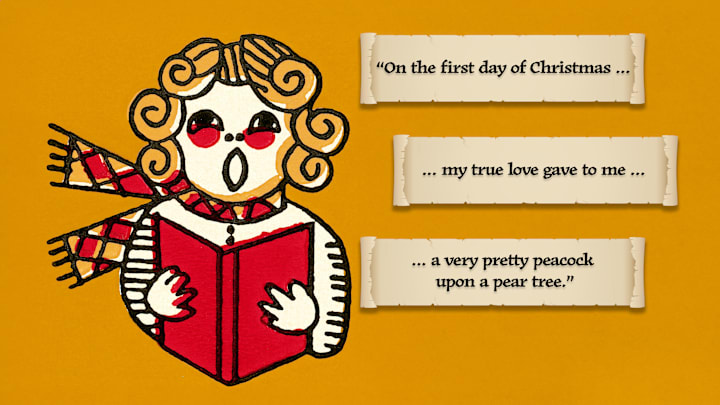First published in English in 1780, “The Twelve Days of Christmas” (actually the 12 days after Christmas) is thought to have originated in France as a children’s forfeit game with ever more elaborate gifts added to the collection, verse by verse, as a test of memory. Whatever its origins may be, however, as the carol grew in popularity throughout the 19th century, numerous versions and variations of its lyrics began to emerge.
Some of these differences still survive in different versions sung today: The traditional “five gold rings” are sometimes described as “five golden rings,” and while some performances describe what “my true love gave to me,” others say the gifts were “sent to me.” But these kinds of subtle differences are nothing compared to some of the gifts in the song’s earlier incarnations.
1. “A Very Pretty Peacock”

One early version of “The Twelve Days of Christmas” was recorded by the Scottish poet and artist William Scott Bell in 1892. Although most of Bell’s lyrics are identical to what we sing today, in his version each verse concludes not with “a partridge in a pear tree,” but with a considerably more ostentatious “very pretty peacock upon a pear tree.”
2. “Four Canary Birds”

In the original 1780 version, the “four calling birds” are instead described as “four colly birds.” Colly—literally “coaly”—is an old English dialect word meaning “soot-black.” By the mid-19th century, however, the word colly had largely fallen out of use, leaving several Victorian editions of “The Twelve Days of Christmas” to come up with their own replacements. “Colour’d birds” and even “curley birds” were used in some editions, while an exotic “four canary birds” were added to the lyrics of one version. The now standard “four calling birds” first appeared in the early 1900s.
3. and 4. “Eight Hares A-Running” and “Eleven Badgers Baiting”

In 1869, an article appeared in an English magazine called The Cliftonian that described a traditional Christmas in rural Gloucestershire, southwest England. The author of the piece wrote that he had heard some local carol singers singing a curious Christmas song, which he noted for the “peculiarity and the utter absurdity of the words.” After outlining the first two of “The Twelve Days of Christmas,” he went on to explain that the carol “proceeds in this ascending manner until on the twelfth day of Christmas the young lady receives … [an] astounding tribute of true love”—among which are “eight hares a-running” and “eleven badgers baiting.”
5., 6., 7., and 8. “Seven Squabs A-Swimming,” “Eight Hounds A-Running,” “Nine Bears A-Beating,” And “Ten Cocks A-Crowing”

One of the earliest American versions of “The Twelve Days of Christmas” was listed in The American Journal of Folklore in 1900. Credited to a contributor from Salem, Massachusetts, and dated to “about 1800,” there are no pipers, drummers, maids, or swans here (and lords and ladies had a number change). Instead, in their place are “ten cocks a-crowing,” “nine bears a-beating,” “eight hounds a-running,” and “seven squabs a-swimming.”
9., 10., and 11. “Ten Asses Racing,” “Eleven Bulls A-Beating,” and “Part of a Mistletow Bough”

An edition of “The Twelve Days of Christmas” included in Folk Songs From Somerset published in 1911 discarded the “pipers piping” and “lords a-leaping” in favor of “eleven bulls a-beating” and “ten asses racing.” In fact, not even the partridge in the pear tree made the final cut here: In its place was a “part of a mistletoe bough.”
12. and 13. “Ten Ships A-Sailing” and “Eleven Ladies Spinning”

In an 1842 edition of Specimens of Lyric Poetry, out went the “ten drummers drumming” and the “eleven lords a-leaping” (downgraded to only nine lords, still a-leaping) and in came “ten ships a-sailing” and “eleven ladies spinning.” Not only that, but this edition also explained in a footnote how “The Twelve Days of Christmas” might once have been used: “Each child in succession repeats the gifts of the day, and forfeits for each mistake. The accumulative process is a favourite with children.”
14. and 15. “A Bull That Was Brown” and “An Arabian Baboon”

An alternative Scots version of “The Twelve Day of Christmas” was reported in use in Scotland in the first half of the 19th century before finding its way into a collection of Popular Rhymes of Scotland published in 1847. Although there are a handful of similarities between this version and the version we’d sing today (“ducks a-merry laying” and “swans a-merry swimming” both make an appearance), relatively little of what we’d recognize remains intact. “The king sent his lady on the first Yule day,” is the new opening line, and many of the gifts are given in sets of three rather than as part of a larger 12-part sequence—but it’s what the gifts themselves are that is the most striking. Alongside the swans and ducks, the king sends his lady “a bull that was brown,” “a goose that was gray,” “three plovers,” “a papingo-aye” (an old Scots dialect word for a parrot, although occasionally translated as peacock)—and, just when things can’t get any stranger, “an Arabian baboon.”
